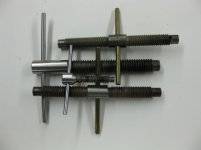clarnibass
Aluminum
- Joined
- Dec 23, 2015
Hi
Asking for a friend.
He is trying to thread blackwood 32TPI. Diameters I think are about 20mm and 25mm. What happens is it starts fine for the first couple of cuts, then the wood breaks and crumbles. Small cuts of about 0.001"-0.002".
Thread is 55° and compound is at 27.5° (I suggested maybe try closer to 27° in case it's slightly more than 27.7° but probably not he issue anyway).
He tried various speeds, from 120RPM to 400RPM and also turning the chuck by hand.
Some suggestions were to freeze before cutting, that the wood is too dry or problematic for this, take large cuts, or cut "by hand" with a thread chaser or other tool. Another idea was to use a thread mill cutter on a rotary tool.
Any suggestions other than those? Somehow to be able to do it with the regular threading tool?
Thanks
Asking for a friend.
He is trying to thread blackwood 32TPI. Diameters I think are about 20mm and 25mm. What happens is it starts fine for the first couple of cuts, then the wood breaks and crumbles. Small cuts of about 0.001"-0.002".
Thread is 55° and compound is at 27.5° (I suggested maybe try closer to 27° in case it's slightly more than 27.7° but probably not he issue anyway).
He tried various speeds, from 120RPM to 400RPM and also turning the chuck by hand.
Some suggestions were to freeze before cutting, that the wood is too dry or problematic for this, take large cuts, or cut "by hand" with a thread chaser or other tool. Another idea was to use a thread mill cutter on a rotary tool.
Any suggestions other than those? Somehow to be able to do it with the regular threading tool?
Thanks


 ) are doing that then 27.5º or 27º is okay just not more.
) are doing that then 27.5º or 27º is okay just not more.